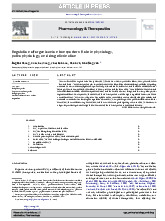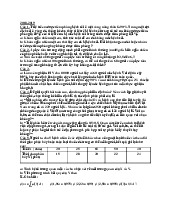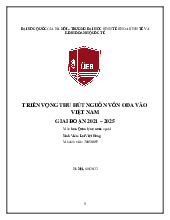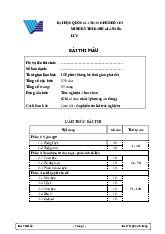


















Preview text:
Table of Contents 1. Introduction 1.1 Purpose 1.2 Scope
1.3 Definitions, Acronyms, and Abbreviations. 1.4 References 1.5 Overview 2. The Overall Description 2.1 Product Perspective 2.1.1 System Interfaces 2.1.2 Interfaces 2.1.3 Hardware Interfaces 2.1.4 Software Interfaces
2.1.5 Communications Interfaces 2.1.6 Memory Constraints 2.1.7 Operations
2.1.8 Site Adaptation Requirements 2.2 Product Functions 2.3 User Characteristics 2.4 Constraints
2.5 Assumptions and Dependencies
2.6 Apportioning of Requirements. 3. Specific Requirements 3.1 External Interfaces 3.2 Functions 3.3 Performance Requirements
3.4 Logical Database Requirements 3.5 Design Constraints 3.5.1 Standards Compliance
3.6 Software System Attributes 3.6.1 Reliability 3.6.2 Availability 3.6.3 Security 3.6.4 Maintainability 3.6.5 Portability
3.7 Organizing the Specific Requirements 3.7.1 System Mode 3.7.2 User Class 3.7.3 Objects 3.7.4 Feature 3.7.5 Stimulus 3. 7.6 Response 3.7.7 Functional Hierarchy 3.8 Additional Comments 4. Change Management Process 5. Document Approvals 6. Supporting Information lOMoARcPSD|45740413 Srs - tdghdt
Xác suất thống kê y học (Đại học Huế) Scan to open on Studocu
Studocu is not sponsored or endorsed by any college or university Downloaded by Mai Anh (Vj4@gmail.com) lOMoARcPSD|45740413
Software Requirements Specifications Document
CS330 Software Engineering
Software Requirements Specification (SRS) Template Items that are intended to stay in
as part of your document are in bold; explanatory comments are in italic text. Plain text is
used where you might insert wording about your project.
The document in this file is an annotated outline for specifying software requirements,
adapted from the IEEE Guide to Software Requirements Specifications (Std 830-1993).
Tailor this to your needs, removing explanatory comments as you go along.
Where you decide to omit a section, keep the header, but insert a comment saying why you omit the data.
/libre/a2f812e8a950a7ad38b0af34348bb711 Page 1 of 30 12/22/23f Downloaded by Mai Anh (Vj4@gmail.com) lOMoARcPSD|45740413
Software Requirements Specifications Document (Project Title) (Team Name and Number) (Team Members)
Software Requirements Specification Document Version: (n) Date: (mm/dd/yyyy)
/libre/a2f812e8a950a7ad38b0af34348bb711 Page 2 of 30 12/22/23f Downloaded by Mai Anh (Vj4@gmail.com) lOMoARcPSD|45740413
Software Requirements Specifications Document Table of Contents 1. Introduction 1.1 Purpose 1.2 Scope
1.3 Definitions, Acronyms, and Abbreviations 1.4 References 1.5 Overview
2. The Overall Description
2.1 Product Perspective 2.1.1 System Interfaces 2.1.2 Interfaces 2.1.3 Hardware Interfaces 2.1.4 Software Interfaces
2.1.5 Communications Interfaces 2.1.6 Memory Constraints 2.1.7 Operations
2.1.8 Site Adaptation Requirements 2.2 Product Functions
2.3 User Characteristics 2.4 Constraints
2.5 Assumptions and Dependencies
2.6 Apportioning of Requirements
3. Specific Requirements
3.1 External interfaces 3.2 Functions
3.3 Performance Requirements
3.4 Logical Database Requirements 3.5 Design Constraints 3.5.1 Standards Compliance
3.6 Software System Attributes 3.6.1 Reliability 3.6.2 Availability 3.6.3 Security 3.6.4 Maintainability 3.6.5 Portability
/libre/a2f812e8a950a7ad38b0af34348bb711 Page 3 of 30 12/22/23f Downloaded by Mai Anh (Vj4@gmail.com) lOMoARcPSD|45740413
Software Requirements Specifications Document
3.7 Organizing the Specific Requirements 3.7.1 System Mode 3.7.2 User Class 3.7.3 Objects 3.7.4 Feature 3.7.5 Stimulus 3.7.6 Response 3.7.7 Functional Hierarchy
3.8 Additional Comments
4. Change Management Process 5. Document Approvals
6. Supporting Information
/libre/a2f812e8a950a7ad38b0af34348bb711 Page 4 of 30 12/22/23f Downloaded by Mai Anh (Vj4@gmail.com) lOMoARcPSD|45740413
Software Requirements Specifications Document 1. Introduction
The following subsections of the Software Requirements Specifications (SRS) document should
provide an overview of the entire SRS. The thing to keep in mind as you write this document is
that you are telling what the system must do – so that designers can ultimately build it. Do not
use this document for design!!! 1.1 Purpose
Identify the purpose of this SRS and its intended audience. In this subsection, describe the
purpose of the particular SRS and specify the intended audience for the SRS. 1.2 Scope In this subsection:
(1) Identify the software product(s) to be produced by name (2) Explain what the software
product(s) will, and, if necessary, will not do (3) Describe the application of the software being
specified, including relevant benefits, objectives, and goals
(4) Be consistent with similar statements in higher-level specifications if they exist This should
be an executive-level summary. Do not enumerate the whole requirements list here.
1.3 Definitions, Acronyms, and Abbreviations.
Provide the definitions of all terms, acronyms, and abbreviations required to properly
interpret the SRS. This information may be provided by reference to one or more appendices
in the SRS or by reference to documents. This information may be provided by reference to an Appendix. 1.4 References In this subsection:
(1) Provide a complete list of all documents referenced elsewhere in the SRS
(2) Identify each document by title, report number (if applicable), date, and publishing organization
(3) Specify the sources from which the references can be obtained.
This information can be provided by reference to an appendix or to another document. If your
application uses specific protocols or RFC’s, then reference them here so designers know where to find them.
/libre/a2f812e8a950a7ad38b0af34348bb711 Page 5 of 30 12/22/23f Downloaded by Mai Anh (Vj4@gmail.com) lOMoARcPSD|45740413
Software Requirements Specifications Document 1.5 Overview In this subsection:
(1) Describe what the rest of the SRS contains (2) Explain how the SRS is organized
Don’t rehash the table of contents here. Point people to the parts of the document they are
most concerned with. Customers/potential users care about section 2, developers care about section 3.
2. The Overall Description
Describe the general factors that affect the product and its requirements. This section does
not state specific requirements. Instead, it provides a background for those requirements,
which are defined in section 3, and makes them easier to understand. In a sense, this section
tells the requirements in plain English for the consumption of the customer. Section3 will
contain a specification written for the developers.
2.1 Product Perspective
Put the product into perspective with other related products. If the product is independent
and totally self-contained, it should be so stated here. If the SRS defines a product that is a
component of a larger system, as frequently occurs, then this subsection relates the
requirements of the larger system to functionality of the software and identifies interfaces
between that system and the software. If you are building a real system,compare its similarity
and differences to other systems in the marketplace. If you are doing a research-oriented
project, what related research compares to the system you are planning to build.
A block diagram showing the major components of the larger system, interconnections, and
external interfaces can be helpful. This is not a design or architecture picture. It is more to
provide context, especially if your system will interact with external actors. The system you
are building should be shown as a black box. Let the design document present the internals.
The following subsections describe how the software operates inside various constraints.
2.1.1 System Interfaces
List each system interface and identify the functionality of the software to accomplish the
system requirement and the interface description to match the system. These are external
systems that you have to interact with. For instance, if you are building a business
/libre/a2f812e8a950a7ad38b0af34348bb711 Page 6 of 30 12/22/23f Downloaded by Mai Anh (Vj4@gmail.com) lOMoARcPSD|45740413
Software Requirements Specifications Document
application that interfaces with the existing employee payroll system, what is the API to that
system that designer’s will need to use? 2.1.2 Interfaces Specify:
(1) The logical characteristics of each interface between the software product and its users.
(2) All the aspects of optimizing the interface with the person who must use the system This is
a description of how the system will interact with its users. Is there a GUI, a command line or
some other type of interface? Are there special interface requirements?
If you are designing for the general student population for instance, what is the impact of ADA
(American with Disabilities Act) on your interface?
2.1.3 Hardware Interfaces
Specify the logical characteristics of each interface between the software product and the
hardware components of the system. This includes configuration characteristics. It also covers
such matters as what devices are to be supported, how they are to be supported and protocols.
This is not a description of hardware requirements in the sense that “This program must run
on a Mac with 64M of RAM”. This section is for detailing the actual hardware devices your
application will interact with and control. For instance, if you are controlling X10 type home
devices, what is the interface to those devices? Designers should be able to look at this and
know what hardware they need to worry about in the design. Many business type applications
will have no hardware interfaces. If none, just state “The system has no hardware interface
requirements” If you just delete sections that are not applicable, then readers do not know if:
a. this does not apply or b. you forgot to include the section in the first place.
2.1.4 Software Interfaces
Specify the use of other required software products and interfaces with other application
systems. For each required software product, include: (1) Name (2) Mnemonic
(3) Specification number (4) Version number (5) Source
For each interface, provide:
(1) Discussion of the purpose of the interfacing software as related to this software product
(2) Definition of the interface in terms of message content and format
/libre/a2f812e8a950a7ad38b0af34348bb711 Page 7 of 30 12/22/23f Downloaded by Mai Anh (Vj4@gmail.com) lOMoARcPSD|45740413
Software Requirements Specifications Document
Here we document the APIs, versions of software that we do not have to write, but that our
system has to use. For instance if your customer uses SQL Server 7 and you are required to use
that, then you need to specify i.e.
2.1.4.1 Microsoft SQL Server 7. The system must use SQL Server as its database component.
Communication with the DB is through ODBC connections. The system must provide SQL data
table definintions to be provided to the company DBA for setup.
A key point to remember is that you do NOT want to specify software here that you think
would be good to use. This is only for customer-specified systems that you have to interact
with. Choosing SQL Server 7 as a DB without a customer requirement is a Design choice, not a
requirement. This is a subtle but important point to writing good requirements and not over- constraining the design.
2.1.5 Communications Interfaces
Specify the various interfaces to communications such as local network protocols, etc.
These are protocols you will need to directly interact with. If you happen to use web services
transparently to your application then do not list it here. If you are using a custom protocol to
communicate between systems, then document that protocol here so designers know what to
design. If it is a standard protocol, you can reference an existing document or RFC.
2.1.6 Memory Constraints
Specify any applicable characteristics and limits on primary and secondary memory.
Don’t just make up something here. If all the customer’s machines have only 128K of RAM,
then your target design has got to come in under 128K so there is an actual requirement. You
could also cite market research here for shrink-wrap type applications
“Focus groups have determined that our target market has between 256-512M of RAM,
therefore the design footprint should not exceed 256M.” If there are no memory constraints, so state. 2.1.7 Operations
Specify the normal and special operations required by the user such as: (1) The various modes
of operations in the user organization (2) Periods of interactive operations and periods of
unattended operations (3) Data processing support functions
(4) Backup and recovery operations
(Note: This is sometimes specified as part of the User Interfaces section.) If you separate this
from the UI stuff earlier, then cover business process type stuff that would impact the design.
For instance, if the company brings all their systems down at midnight for data backup that
might impact the design. These are all the work tasks that impact the design of an
application, but which might not be located in software.
/libre/a2f812e8a950a7ad38b0af34348bb711 Page 8 of 30 12/22/23f Downloaded by Mai Anh (Vj4@gmail.com) lOMoARcPSD|45740413
Software Requirements Specifications Document
2.1.8 Site Adaptation Requirements In this section:
(1) Define the requirements for any data or initialization sequences that are specific to a
given site, mission, or operational mode
(2) Specify the site or mission-related features that should be modified to adapt the software
to a particular installation
If any modifications to the customer’s work area would be required by your system, then
document that here. For instance, “A 100Kw backup generator and 10000 BTU air
conditioning system must be installed at the user site prior to software installation”.
This could also be software-specific like, “New data tables created for this system must be
installed on the company’s existing DB server and populated prior to system activation.” Any
equipment the customer would need to buy or any software setup that needs to be done so
that your system will install and operate correctly should be documented here. 2.2 Product Functions
Provide a summary of the major functions that the software will perform. Sometimes the
function summary that is necessary for this part can be taken directly from the section of the
higher-level specification (if one exists) that allocates particular functions to the software product. For clarity:
(1) The functions should be organized in a way that makes the list of functions
understandable to the customer or to anyone else reading the document for the first time.
(2) Textual or graphic methods can be used to show the different functions and their
relationships. Such a diagram is not intended to show a design of a product but simply shows
the logical relationships among variables.
AH, Finally the real meat of section 2. This describes the functionality of the system in the
language of the customer. What specifically does the system that will be designed have to do?
Drawings are good, but remember this is a description of what the system needs to do, not
how you are going to build it. (That comes in the design document).
2.3 User Characteristics
Describe those general characteristics of the intended users of the product including
educational level, experience, and technical expertise. Do not state specific requirements but
rather provide the reasons why certain specific requirements are later specified in section 3.
/libre/a2f812e8a950a7ad38b0af34348bb711 Page 9 of 30 12/22/23f Downloaded by Mai Anh (Vj4@gmail.com) lOMoARcPSD|45740413
Software Requirements Specifications Document
What is it about your potential user base that will impact the design? Their experience and
comfort with technology will drive UI design. Other characteristics might actually influence
internal design of the system. 2.4 Constraints
Provide a general description of any other items that will limit the developer’s options. These can include:
(1) Regulatory policies
(2) Hardware limitations (for example, signal timing requirements) (3) Interface to other applications (4) Parallel operation (5) Audit functions (6) Control functions
(7) Higher-order language requirements
(8) Signal handshake protocols (for example, XON-XOFF, ACK-NACK) (9) Reliability requirements
(10) Criticality of the application
(11) Safety and security considerations
This section captures non-functional requirements in the customers language. A more formal
presentation of these will occur in section 3.
2.5 Assumptions and Dependencies
List each of the factors that affect the requirements stated in the SRS. These factors are not
design constraints on the software but are, rather, any changes to them that can affect the
requirements in the SRS. For example, an assumption might be that a specific operating
system would be available on the hardware designated for the software product. If, in fact, the
operating system were not available, the SRS would then have to change accordingly.
This section is catch-all for everything else that might influence the design of the system and
that did not fit in any of the categories above.
2.6 Apportioning of Requirements.
Identify requirements that may be delayed until future versions of the system. After you look
at the project plan and hours available, you may realize that you just cannot get everything
done. This section divides the requirements into different sections for development and
delivery. Remember to check with the customer – they should prioritize the requirements and
decide what does and does not get done. This can also be useful if you are using an iterative
life cycle model to specify which requirements will map to which interation.
/libre/a2f812e8a950a7ad38b0af34348bb711 Page 10 of 30 12/22/23f Downloaded by Mai Anh (Vj4@gmail.com) lOMoARcPSD|45740413
Software Requirements Specifications Document
3. Specific Requirements
This section contains all the software requirements at a level of detail sufficient to enable
designers to design a system to satisfy those requirements, and testers to test that the system
satisfies those requirements. Throughout this section, every stated requirement should be
externally perceivable by users, operators, or other external systems. These requirements
should include at a minimum a description of every input (stimulus) into the system, every
output (response) from the system and all functions performed by the system in response to
an input or in support of an output. The following principles apply: (1) Specific requirements
should be stated with all the characteristics of a good SRS correct unambiguous complete consistent
ranked for importance and/or stability verifiable modifiable traceable
(2) Specific requirements should be cross-referenced to earlier documents that relate (3) All
requirements should be uniquely identifiable (usually via numbering like 3.1.2.3) (4) Careful
attention should be given to organizing the requirements to maximize readability (Several
alternative organizations are given at end of document) Before examining specific ways of
organizing the requirements it is helpful to understand the various items that comprise
requirements as described in the following subclasses.
This section reiterates section 2, but is for developers not the customer. The customer buys in
with section 2, the designers use section 3 to design and build the actual application.
Remember this is not design. Do not require specific software packages, etc unless the
customer specifically requires them. Avoid over-constraining your design. Use proper terminology:
The system shall… A required, must have feature The system should… A desired feature, but
may be deferred til later The system may… An optional, nice-to-have feature that may never
make it to implementation.
Each requirement should be uniquely identified for traceability. Usually, they are numbered
3.1, 3.1.1, 3.1.2.1 etc. Each requirement should also be testable. Avoid imprecise statements
like, “The system shall be easy to use” Well no kidding, what does that mean? Avoid
“motherhood and apple pie” type statements, “The system shall be developed using good
software engineering practice”
Avoid examples, This is a specification, a designer should be able to read this spec and build
the system without bothering the customer again. Don’t say things like, “The
/libre/a2f812e8a950a7ad38b0af34348bb711 Page 11 of 30 12/22/23f Downloaded by Mai Anh (Vj4@gmail.com) lOMoARcPSD|45740413
Software Requirements Specifications Document
system shall accept configuration information such as name and address.” The designer
doesn’t know if that is the only two data elements or if there are 200. List every piece of
information that is required so the designers can build the right UI and data tables.
3.1 External Interfaces
This contains a detailed description of all inputs into and outputs from the software system. It
complements the interface descriptions in section 2 but does not repeat information there.
Remember section 2 presents information oriented to the customer/user while section 3 is
oriented to the developer.
It contains both content and format as follows: Name of item Description of purpose
Source of input or destination of output
Valid range, accuracy and/or tolerance Units of measure Timing
Relationships to other inputs/outputs
Screen formats/organization
Window formats/organization Data formats Command formats End messages 3.2 Functions
Functional requirements define the fundamental actions that must take place in the software
in accepting and processing the inputs and in processing and generating the outputs. These
are generally listed as “shall” statements starting with “The system shall… These include:
Validity checks on the inputs
Exact sequence of operations
Responses to abnormal situation, including Overflow
Communication facilities
Error handling and recovery Effect of parameters
Relationship of outputs to inputs, including Input/Output sequences
/libre/a2f812e8a950a7ad38b0af34348bb711 Page 12 of 30 12/22/23f Downloaded by Mai Anh (Vj4@gmail.com) lOMoARcPSD|45740413
Software Requirements Specifications Document
Formulas for input to output conversion
It may be appropriate to partition the functional requirements into sub-functions or sub-
processes. This does not imply that the software design will also be partitioned that way.
3.3 Performance Requirements
This subsection specifies both the static and the dynamic numerical requirements placed on
the software or on human interaction with the software, as a whole. Static numerical
requirements may include:
(a) The number of terminals to be supported (b) The number of simultaneous users to be
supported (c) Amount and type of information to be handled Static numerical requirements
are sometimes identified under a separate section entitled capacity.
Dynamic numerical requirements may include, for example, the numbers of transactions and
tasks and the amount of data to be processed within certain time periods for both normal and peak workload conditions.
All of these requirements should be stated in measurable terms. For example,
95% of the transactions shall be processed in less than 1 second rather than,
An operator shall not have to wait for the transaction to complete.
(Note: Numerical limits applied to one specific function are normally specified as part of the
processing subparagraph description of that function.) 3.4 Logical Database Requirements
This section specifies the logical requirements for any information that is to be placed into a
database. This may include:
Types of information used by various functions Frequency of use Accessing capabilities
Data entities and their relationships Integrity constraints
/libre/a2f812e8a950a7ad38b0af34348bb711 Page 13 of 30 12/22/23f Downloaded by Mai Anh (Vj4@gmail.com) lOMoARcPSD|45740413
Software Requirements Specifications Document
Data retention requirements
If the customer provided you with data models, those can be presented here. ER
diagrams (or static class diagrams) can be useful here to show complex data relationships.
Remember a diagram is worth a thousand words of confusing text. 3.5 Design Constraints
Specify design constraints that can be imposed by other standards, hardware limitations, etc.
3.5.1 Standards Compliance
Specify the requirements derived from existing standards or regulations. They might include: (1) Report format (2) Data naming
(3) Accounting procedures (4) Audit Tracing
For example, this could specify the requirement for software to trace processing activity.
Such traces are needed for some applications to meet minimum regulatory or financial
standards. An audit trace requirement may, for example, state that all changes to a payroll
database must be recorded in a trace file with before and after values.
3.6 Software System Attributes
There are a number of attributes of software that can serve as requirements. It is important
that required attributes by specified so that their achievement can be objectively verified. The
following items provide a partial list of examples. These are also known as non-functional
requirements or quality attributes.
These are characteristics the system must possess, but that pervade (or cross-cut) the design.
These requirements have to be testable just like the functional requirements. Its easy to start
philosophizing here, but keep it specific. 3.6.1 Reliability
Specify the factors required to establish the required reliability of the software system at time
of delivery. If you have MTBF requirements, express them here. This doesn’t refer to just
having a program that does not crash. This has a specific engineering meaning. 3.6.2 Availability
/libre/a2f812e8a950a7ad38b0af34348bb711 Page 14 of 30 12/22/23f Downloaded by Mai Anh (Vj4@gmail.com) lOMoARcPSD|45740413
Software Requirements Specifications Document
Specify the factors required to guarantee a defined availability level for the entire system such
as checkpoint, recovery, and restart. This is somewhat related to reliability. Some systems run
only infrequently on-demand (like MS Word). Some systems have to run 24/7 (like an e-
commerce web site). The required availability will greatly impact the design. What are the
requirements for system recovery from a failure? “The system shall allow users to restart the
application after failure with the loss of at most 12
characters of input”. 3.6.3 Security
Specify the factors that would protect the software from accidental or malicious access, use,
modification, destruction, or disclosure. Specific requirements in this area could include the need to:
Utilize certain cryptographic techniques
Keep specific log or history data sets
Assign certain functions to different modules




